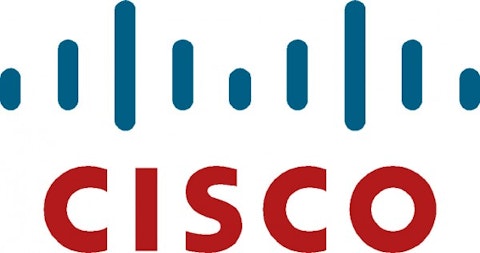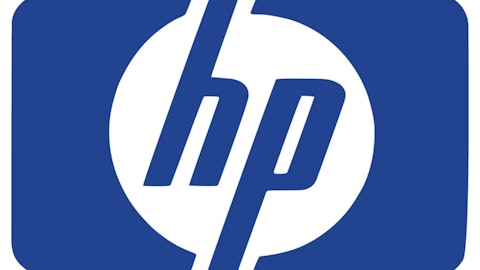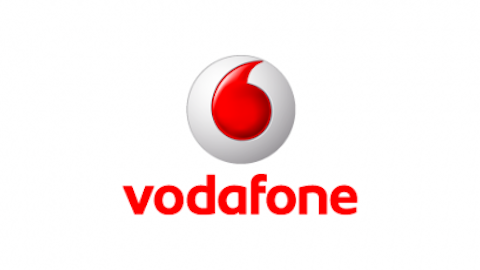Cisco Systems, Inc. (NASDAQ:CSCO), the networking giant, reported its Q2 earnings last week. Revenue grew by 5% on a year-on-year basis while net income grew 44% on the same basis. During the quarter Cisco returned a total of $1.2 billion to shareholders through a combination of share buybacks, totaling $500 million, and dividends, totaling $743 million. Free cash flow for the first two quarters has grown from $4.89 billion last year to $5.26 billion this year, growth of 7.7%.
Cisco has a long history of poor acquisitions, guilty of what Peter Lynch called ‘deworseification,’ but it seems that the company has become more focused on their core business. Cisco is selling Linksys, which it acquired in 2003, to Belkin for most likely less than Cisco originally paid for the company. Linksys sells routers and networking equipment aimed at homes while Cisco’s main competency is in the enterprise. Hopefully this ends Cisco’s attempts to expand into the consumer technology space, which have been a universal failure for the company.

A fortress balance sheet
Cisco, like many large tech giants, has an enormous amount of cash sitting on its balance sheet. At the end of Q2 Cisco had $46.3 billion in cash and cash equivalents and $16.3 billion in debt, a net cash position of $30 billion or $5.60 per share. With a current market price around $21 per share cash alone makes up a full 26.6% of the company’s total market capitalization.
A robust cash flow
Cisco is very good at making money. In fiscal 2012 Cisco recorded $10.3 billion in free cash flow. If we assume that the 7.7% growth for the first six months applies to the full year FCF for 2013 would reach about $11.1 billion. This is $2.07 per share, up from $1.91 per share in 2012.
Being a mature company Cisco will see most of its growth going forward come from acquisitions. But because the cash flow is so strong Cisco can grow per-share numbers considerably with share buybacks. With annual free cash flow at about 10% of the market cap, the company could boost earnings per share by 10% without growing at all.
Cisco started paying a dividend in 2011 and has grown that dividend to $0.56 per share annually since then. The payout ratio as a percentage of free cash flow is about 29%. Again, even without earnings growth, the dividend can be increased substantially. If free cash flow were to stay constant Cisco could raise its dividend by 10% annually for six years before the payout ratio hit 50%.
Data from Morningstar
How much is Cisco worth?
I’ll do a simple discounted cash flow calculation to estimate the fair value of a share of Cisco. For a discount rate I’ll use both 12% and 15% to define a fair value range.
Because projecting growth is difficult I’ll do this calculation for three different scenarios:
- No-growth – Free cash flow remains at the 2012 level indefinitely.
- Slow-growth – Free cash flow grows by 3% annually in perpetuity.
- Realistic-growth – Free cash flow grows by 6% annually for the next 10 years and 3% annually after that
The fair value ranges for each of these scenarios are shown in the table below. In each case, the net cash of $5.60 per share has been added to the value of the future cash flows.
| Scenario | Low-end | High-end |
|---|---|---|
| No-growth | $18.33 | $21.52 |
| Slow-growth | $21.99 | $27.46 |
| Realistic-growth | $25.39 | $32.49 |
Cisco is currently valued as if the company will never grow again. This seems overly pessimistic. Cisco traded below $16 a share at one point last year, which is clearly an absurd price given the calculation above. I took advantage of that absurd price when I bought my shares last year, but even today the stock offers value. The realistic-growth scenario suggests a fair value between 20% and 54% higher than the current share price. Even after a run-up of about 30% from its low in the middle of last year, Cisco is still undervalued.
The competition
The fact that Cisco has been able to keep gross margins above 60% over the past decade should tell you something about Cisco’s economic moat. Juniper Networks, Inc. (NYSE:JNPR), a much smaller rival, trades at a significantly loftier valuation than Cisco. Revenue for Juniper actually decreased in 2012 along with free cash flow. A P/FCF ratio of nearly 50 makes the stock seem a bit outrageous.
Hewlett-Packard Company (NYSE:HPQ) is a big competitor in the enterprise switch market, but the company has faced declining revenues and profits over the past few years. HP is a company which tries to do too many things and does most of them poorly, and it may be years before the company can stabilize its cash flows.
Alcatel Lucent SA (ADR) (NYSE:ALU) has been troubled for years, with negative free cash flow every year since 2006. It seems that Cisco is the only company in this space which hasn’t suffered declining revenues, decline profits, or both like most of its competitors.
Here’s an idea of how dominant Cisco is in its core markets. This image is from 2010, but it still should be reasonably accurate.

Do you see all of those colored lines below 20% in the Switching graph? Those are Cisco’s competitors, including the three listed above. Cisco is absolutely dominant in its core markets. Here’s a more recent snapshot of market share.

The Bottom Line
Cisco is a market leader which is priced like a no-growth has-been. Even after a run-up in share price Cisco is still significantly undervalued. With $5.60 in per-share cash and about $2 in per-share free cash flow a stock price of $21 seems almost too good to be true. And with a rapidly increasing dividend and the potential to boost per-share earnings with stock buybacks, Cisco is poised to provide exceptional returns for investors.
The article An Undervalued and Underestimated Tech Giant originally appeared on Fool.com and is written by Timothy Green.
Copyright © 1995 – 2013 The Motley Fool, LLC. All rights reserved. The Motley Fool has a disclosure policy.


